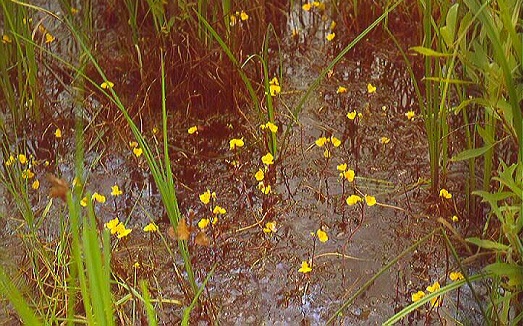According to a new study, certain carnivorous species of plants are becoming vegetarians.
The bladderwort (Utricularia) is a carnivorous plant, which is found in fresh water and wet soil as terrestrial or aquatic species across every continent except Antarctica. All bladderworts are carnivorous and capture small organisms by means of bladder-like traps. Terrestrial species tend to have tiny traps that feed on small prey such as protozoa and rotifers swimming in water-saturated soil. Aquatic bladderworts species possess bladders that are usually larger and can feed on more substantial prey such as water fleas, nematodes and even fish fry, mosquito larvae and young tadpoles.
However, according to the researchers from University of Vienna, these plants are overcoming their natural instincts and converting to vegetarianism. The study states that these carnivorous plants are feasting on algae and pollen grains when prey animals are hard to find.
The study was conducted by Marianne Koller-Peroutka and Wolfram Adlassnig of the University of Vienna’s Core Facility Cell Imaging and Ultrastructure Research and colleagues from the Silver-Stable Isotope Lab and the Gregor Mendel Institute for Molecular Plant Biology.
“Aquatic bladderworts catch their prey with highly sophisticated suction traps consisting of little bladders that produce a hydrostatic under pressure. A valve-like trap door opens upon stimulation and the surrounding water including tiny organism flushes in rapidly within three milliseconds,” said Adlassnig
The bladderwort’s digestive enzymes degrade the prey once it gets trapped. Sometimes algae and pollen grains also come into this trap. Researchers analyzed over 2,000 objects in traps of bladderworts and found that just 10% were animals and 50% algae. One third of the prey consisted of pollen grains. However, bladderwort did not appear to select what it ate. In fact it sucks in all living things, plants or animals that fit in its traps.
“Previously, algae and pollen had been considered as useless bycatch which was accidentally sucked in together with animal prey. However, data on trapped algae and the growth of the plant as well as the formation of hibernation buds leads to a completely new insight: Utricularia plants that had trapped successfully numerous algae and pollen grains were larger and formed more biomass. Thus it can be concluded that Utricularia gains specific nutrients like nitrogen mainly from animal prey whereas other nutrients like micro-nutrients and trace elements were derived mainly from algae and pollen,” added Koller-Peroutka

